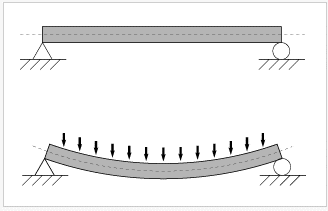|
|
|
|
|
|
|
|
BEAM. A beam is a structural element
that carries load primarily in bending (flexure). Beams generally
carry vertical gravitational forces but can also be used to
carry horizontal loads (i.e. loads due to an earthquake).
The loads carried by a beam are transferred to columns, walls,
or girders, which then transfer the force to adjacent structural
compression members. In Light frame construction the joists
rest on the beam.
Beams are characterized by their profile (the shape of their
cross-section), their length, and their material. In contemporary
construction, beams are typically made of steel, reinforced
concrete, or wood. One of the most common types of steel beam
is the I-beam or wide-flange beam (also known as a "universal
beam" or, for stouter sections, a "universal column").
This is commonly used in steel-frame buildings and bridges.
Other common beam profiles are the C-channel, the hollow structural
section beam, the pipe, and the angle.
|

A
statically determinate beam, bending under an evenly distributed
load
|
|
|
All
Rights Reserved. This 2006 International Building Code® is a
copyrighted work owned by the International Code Council, Inc. Without
advance written permission from the copyright owner, no part of
this book may be reproduced, distributed, or transmitted in any
form or by any means, including, without limitation, electronic,
optical or mechanical means (by way of example and not limitation,
photocopying, or recording by or in an information storage retrieval
system). For information on permission to copy material exceeding
fair use, please contact: Publications, 4051West Flossmoor Road,
Country Club Hills, IL 60478-5795. Phone 1-888-ICC-SAFE (422-7233).
Trademarks: “International Code Council,” the “International
Code Council” logo and the “International Building Code”
are trademarks of the International Code Council, Inc.
|
|